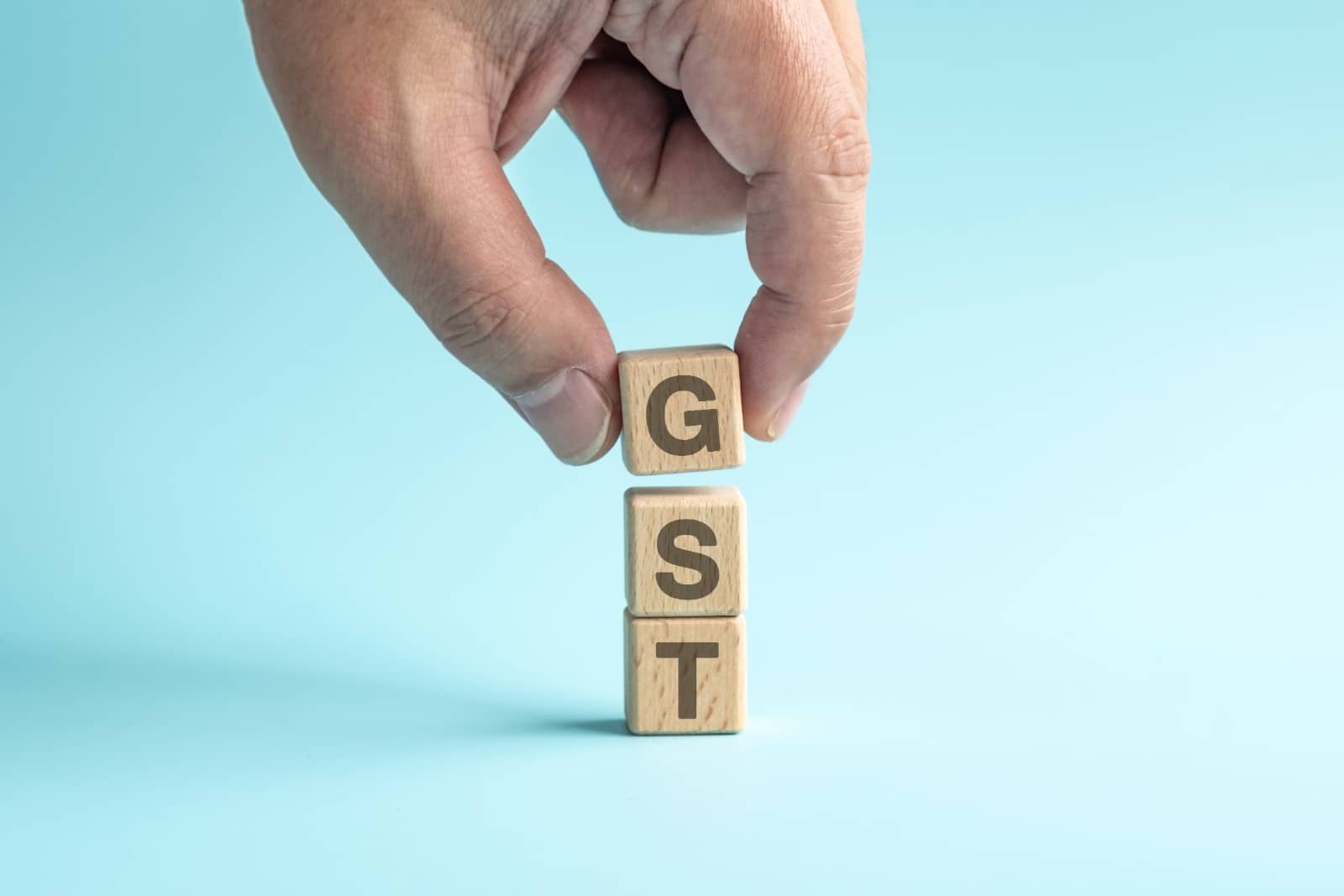GST stands for ‘goods and services tax’. It’s a 15% tax that’s added onto the price of goods and services in New Zealand. GST will impact your business if you are ‘registered for GST’. As a business that’s registered for GST, you will add GST onto products and services you sell, collect it from your customers, then pass it onto the government when you file a GST return. You can also claim back GST that you have paid when buying goods or services that are related to your line of business. So, knowing all this, the very first question you’ll want to ask is:
Do I have to register my business for GST?
You need to register for GST if you have a company that earns more than $60,000 a year, or you earn more than $60,000 a year as a self-employed individual.
If you’re an individual, the $60,000 threshold applies only to the income you earn that isn’t liable to PAYE. For example, if you do $15,000 worth of freelancing on top of a salary that has PAYE applied to it, you don’t have to register for GST. But you can if you want to.
Some people register for GST even if they don’t have to. It means they can claim GST on materials and services they use for their business. If you decide to go this way, you need to be aware that your prices to customers must include GST. Also, you are obligated to do GST returns on time, every time.
Where and how do I register for GST?
If you have to (or want to) register for GST, you will first need to log into myIR, the IRD’s secure online services portal. If you’ve never done this before, you’ll start by registering for myIR. The IRD site tells you how to do this. Registering for myIR requires you to have your IRD number handy, along with all the usual identification information.
Once you’ve logged in to myIR, you need to select the option within your profile to ‘Register for a new tax account’. Then you’ll need to know the IRD number of the person or company you are registering; your bank account number for GST refunds; business turnover (total sales) in the last 12 months; and expected turnover for the next 12 months. You’ll also have to enter a BIC (business industry classification) code. The IRD site includes a tool to help you find this.
Part of the registration process involves choosing how often you’ll file your GST returns. In most cases, this means choosing two-monthly or six-monthly. Only businesses with sales of more than $24 million have to file GST returns every month. If you earn over $500,000 per year, you can’t choose the six-monthly filing option.
One more thing; you’ll need to choose between registering for GST on a ‘payments’ or ‘invoice’ basis. Most small businesses choose ‘payments’ basis. Here’s an explanation for each option:
- Payments basis refers to the date you actually receive GST from a sale of goods or services. So if you invoice a customer on 20 August and they pay you a month later (September), the GST you collect from the invoice will be part of your bi-monthly GST return at the end of October.
- Invoice basis refers to the date you send an invoice. So if you invoice a customer in October, you will need to include that invoice in your GST return at the end of October – before you actually receive the money. For bigger companies this is usually not a problem, however it can result in cashflow problems for small businesses, freelancers and sole traders.
GST basics explained
If you register for GST, you’re obliged to charge an extra 15% on top of your normal prices. So, if you’re a service business that charges $90 an hour, being registered for GST means you’ll have to charge $90 + 15% ($103.50 an hour). And if you’re a manufacturer who makes widgets that sell for $50, you need to add 15% GST. This brings your widget cost to $57.50. To work out the GST, simply multiply your price by 1.15.
Obviously you can play with pricing components to reach a GST inclusive price that suits your market. For example, if you want an item to cost $99.95, your ex-GST price is $86.91. There are online GST calculators to help with establishing price points.
When you buy something – goods or services – from an individual or company that’s GST registered, you will be paying GST. Everyone in New Zealand pays GST, even if they’re not registered for it.
The benefit of being registered for GST is that you may be able to claim GST back on goods or services you purchased if they are genuine business expenses.
As a GST-registered person or business, you are collecting and paying GST all the time. So it’s really important to keep a precise record of all the GST you collect and all the GST you pay. This is done through bookkeeping, aka accountancy. It also requires you to keep records of all invoices and receipts that show GST charged or paid. If you buy something from a supplier who is not GST registered, the price would not include GST so there’s no GST for you to claim back on that purchase.
What goods and services are GST-exempt?
There are exceptions to every rule. With GST, there are things called ‘zero-rated supplies’, which aren’t subject to GST. These include some exported and imported services, certain financial services, duty-free goods, exported goods, exported boats and aircraft, newly-refined fine metals…and a whole bunch of other specific goods, services and transactions. To understand them all, it’s best to refer to the IRD web-page about zero-rated supplies.
The most common zero-rated situations relate to international transactions for selling and buying goods or services.
- If you have customers overseas who have no trading base in New Zealand, you aren’t required to charge GST on services or products you sell to them. For example, if you’re a freelance writer and you sell a story to a UK-based newspaper, don’t add GST to your invoice.
- If you buy something for your business from an overseas supplier who has no trading base in New Zealand, you shouldn’t have to pay GST on that purchase. Always check the invoice to see if there’s a GST component. This zero-rated rule also applies if you are purchasing physical materials for your business, such as cushion covers from a supplier in Istanbul for your home décor store.
How do I create a GST invoice?
When you’re an individual or company that’s registered for GST, your invoices are known as ’tax invoices’. They need to include 15% GST, as well as a number of other fields:
- Your trading name
- Your GST number
- Invoice date
- Due date
- A description of the goods or services that are being invoiced
- Subtotal
- Total GST @ 15%
- Total amount due NZD
Another nice-to-have is your logo. It will make your invoice look smarter and more professional.
What is a GST return?
A GST return is a declaration of GST you have collected for a defined period and the GST you have paid when making business purchases. The difference between the two is paid to the IRD.
For example, if you collected $500 GST on your sales for the period and you paid $100 GST on business-related purchases for the same period, the amount of you need to pay to the IRD will be $400. GST collected minus GST paid on eligible expenses.
Sometimes you’ll actually get money back from the IRD. This happens when the GST paid on eligible expenses is greater than the GST collected from sales. While it might feel like a good thing, you don’t really want this to happen too often; it’s an indicator that your business is going backwards.
Here’s a tip: Keep the GST you collect in a separate account, so that the money is there when GST return time comes around. You don’t want to get caught short when it’s time to file your GST return. Failure to pay GST owed can result in penalties.
How do I claim a GST refund?
You can claim GST back from the IRD when you’ve purchased goods or services for your business. You can also claim GST back on bad debts where you have already paid the related GST to the IRD, but this will only apply if you are paying GST on an invoice basis, not a payments basis.
Business expenses vary between industries. You need to be honest about what you’re claiming for. For example, if you claim on a television you supposedly bought for the business, but it lives in your living room at home, you’re not being honest, and you could be penalised if found out. If you’re not sure if an expense is truly business-related, it might be a good idea to talk to an accountant about eligible expenses for your line of work.
If a purchase is for both business and personal use, such as a car or a laptop, you can claim GST for the business portion of use. The IRD has a web page about GST adjustments for assets that are shared between your personal life and business life.
Claiming GST is done when you file a GST return. GST you paid on eligible business expenses is subtracted from the GST you collected on sales.
How do I file a GST return?
Your GST return is due by the 28th of the month after the end of your taxable period. There are a couple of exceptions to this rule. For the period ending 31 March, GST returns are due by 7 May. And for returns related to the period ending 30 November, returns are due by 15 January.
There are three ways to file a GST return. You can do it through myIR, the IRD online portal; you can file a return through some accounting software platforms, like Xero; or you can file a GST return the old-fashioned way by completing a paper form and sending it to the IRD.
When is my GST return due?
To help you understand when GST returns are due, here are the schedules for two-monthly and six-monthly filing:
Two-monthly GST return filing and payment due dates:
- 15 January: GST return and payment for the Period Ending (PE) 30 November
- 28 February: GST return and payment for PE 31 January
- 7 May: GST return and payment for PE 31 March
- 28 June: GST return and payment for PE 31 May
- 28 August: GST return and payment for PE 31 July
- 29 October: GST return and payment for PE 30 September
Six-monthly GST return filing and payment due dates:
- 7 May: GST return and payment for the PE 31 March
- 29 October: GST return and payment for the PE 30 September
Other things you should know about GST
- GST isn’t just for companies that are registered with the Companies Office. You can register for GST as a contractor, freelancer or sole trader.
- Eligible business expenses vary between industries, however you can be pretty sure that it’s okay to claim for business-related vehicle expenses, business travel, rent paid for business space, business-related insurance premiums, work-related journals and magazines, utility charges related to your business space, office equipment and office stationery.
- You don’t need an NZBN number to register for GST, unless you’re a limited company. But you will need an IRD number.
- If you register for GST part-way through a financial year, it only applies to the income in the future – not the income you’ve already earned that year.
- You can’t start charging GST until you receive confirmation that you’re registered for GST.
- GST has nothing to do with income tax or withholding tax. It’s entirely different.
- The tax invoices you create need to be in NZ dollars.
- You can cancel your GST registration at any time by logging into myIR.
- The IRD charges a late filing penalty of $50 if you’re on a payments basis. The penalty is $250 if you’re on an invoices basis.
- You can switch between two-monthly and six-monthly filing in myIR.



